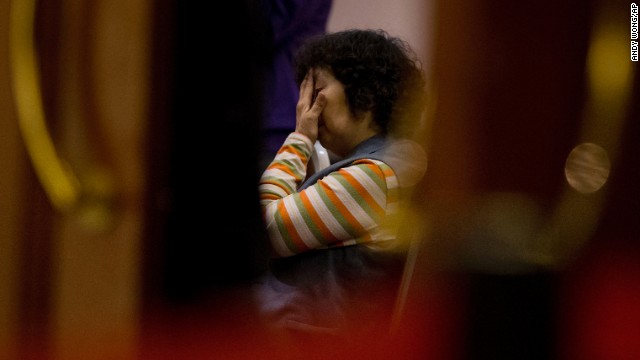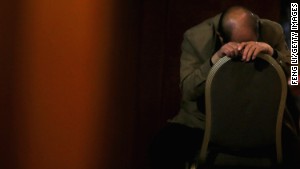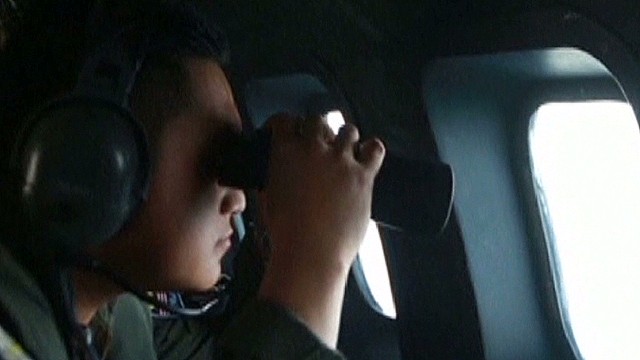New evidence in Flight 370 search explains plane's path
March 19, 2014 -- Updated 0209 GMT (1009 HKT)
STORY HIGHLIGHTS
- NEW: NBC: Programmed change in direction occurred 12 minutes before sign off
- NEW: Analyst: "Sometimes an erratic flight path is heroism, not terrorism"
- Law enforcement official: Plane's turn almost certainly programmed from cockpit
- Officials say nothing on pilots' computers, e-mails indicates deviation was planned
(CNN) -- New information from the Thai government bolsters the belief that missing Malaysia Airlines Flight 370 took a sharp westward turn after communication was lost.
And it looks like that turn was no accident.
A law enforcement official told CNN Tuesday that the aircraft's first turn to the west was almost certainly programmed by somebody in the cockpit.
There is no indication of when the coordinates were entered into the computer. It could have been done during the flight or, as is more common, during preflight preparations, the official said.
A report from NBC News Tuesday night added another twist, claiming the programmed change in direction was made at least 12 minutes before the plane's co-pilot signed off to air traffic controllers, telling them, "All right, good night."
Analysts on CNN's "AC360" offered different interpretations of what that report, if accurate, could mean -- with some experts cautioning the change in direction could have been part of an alternate flight plan programmed in advance in case of emergency.
"We don't know when specifically it was entered," said Mary Schiavo, a CNN aviation analyst and former inspector general for the U.S. Department of Transportation.
New York Times reporter Michael Schmidt said the new timeframe "makes the issue of foul play seem more significant."
"Because by doing that," he said, "what it basically shows is that this thing was already heading in a different direction when they're saying good night."
But still, the new details about what happened don't add up to a clear answer.
"Like everything on this story, we learn a little bit," Schmidt said, "but then we just have more questions."





Evidence that someone programmed the plane's computer and the Thai data that surfaced Tuesday corroborate a leading theory from Malaysian investigators: The missing plane veered off course in a deliberate act by someone who knew what they were doing.
But investigators still don't know who was at the controls, or why whoever was flying the plane apparently took it far from its original destination.
An initial search of the pilots' personal computers and e-mails found nothing to indicate that the sudden deviation in the aircraft's route was planned, U.S. officials said Tuesday after being briefed by Malaysian authorities.
The officials said they had also reviewed cockpit conversations between the plane and air traffic controllers and heard nothing suspicious or anything that would explain why the jetliner changed course.
And a flight simulator belonging to pilot Zaharie Ahmad Shah did not show any of the unexplained paths the plane may have flown after it went off the grid, officials said.
Schiavo said it's no surprise investigators found nothing suspicious in the pilots' homes.
"I've worked on many cases were the pilots were suspect, and it turned out to be a mechanical and horrible problem," she said. "And I have a saying myself: Sometimes an erratic flight path is heroism, not terrorism. And I always remind myself of that, not to jump to that conclusion. Sometimes pilots are fighting amazing battles, and we never hear about it. "
Thailand: Plane sent intermittent signal
The Thai military's revelation that it also spotted the plane turning west toward the Strait of Malacca is one encouraging sign that investigators could be on the right track after days of searching for the missing plane have failed to turn up any answers about its location.
The Thai military was receiving normal flight path and communication data from the Boeing 777-200 on its planned March 8 route from Kuala Lumpur to Beijing until 1:22 a.m., when it disappeared from its radar.
Six minutes later, the Thai military detected an unknown signal, a Royal Thai Air Force spokesman told CNN. This unknown aircraft, possibly Flight 370, was heading the opposite direction.
Malaysia says the evidence suggests that the plane was deliberately flown off-course, turning west and traveling back over the Malay Peninsula and out into the Indian Ocean.
The Thai data are the second radar evidence that the plane did indeed turn around toward the Strait of Malacca.
It follows information from the Malaysian air force that its military radar tracked the plane as it passed over the small island of Pulau Perak in the Strait of Malacca.
"The unknown aircraft's signal was sending out intermittently, on and off and on and off," the spokesman said. The Thai military lost the unknown aircraft's signal because of the limits of its military radar, he said.
Investigators say they're still not sure where the plane ended up.
The latest findings say the plane's last known location detected by a satellite is along two wide arcs: one stretching north over Asia and the other south into the Indian Ocean. The plane's last electronic connection with the satellite was about six hours after it last showed up on Malaysian military radar.




The total area now being searched stands at 2.97 million square miles -- an area nearly the size of the continental United States -- Hishammuddin Hussein, the Malaysian defense and transport minister said.
"This is an enormous search area," Hishammuddin said. "And it is something that Malaysia cannot possibly search on its own. I am therefore very pleased that so many countries have come forward to offer assistance and support to the search and rescue operation."
Turn made by computer?
The pilot and first officer of the missing plane, both of them Malaysian, have come under particular scrutiny in the search for clues.
But officials have reported no evidence to tie the pilot and first officer to the plane's disappearance.
One aviation expert, writing an opinion piece for CNN.com, floated the idea last week that whoever changed the plane's course was an expert.
The cockpit computer programming analysis, first reported by The New York Times Tuesday, has increased investigators' focus on the pilot and first officer, the newspaper said.
Asked about the report Tuesday, Malaysia Airlines Chief Executive Ahmad Jauhari Yahya said, "As far as we're concerned, the aircraft was programmed to fly to Beijing. That's the standard procedure."
But he didn't rule out the possibility the flight path had been reprogrammed.
"Once you're in the aircraft," he said, "anything is possible."
China clears citizens
China says it has found no evidence that any of its citizens on board the missing plane were involved in hijacking or terrorism.
Background checks on all passengers from the Chinese mainland on the plane have found nothing to support such suspicions, Huang Huikang, the Chinese ambassador to Malaysia, said Tuesday, according to the state-run Chinese news agency Xinhua.
Authorities have said they are investigating all 239 people who were on board the flight, which disappeared more than 10 days ago.
According to the airline, 153 of the 227 passengers on board the plane came from mainland China or Hong Kong.
By effectively ruling out suspicions for a large majority of the passengers, Chinese authorities appear to have significantly shortened the list of possible suspects in the investigation.
The Chinese ambassador's statement is also likely to greatly dampen speculation that Uyghur separatists from China's far western region of Xinjiang might have been involved in the plane's disappearance.
One of the two long corridors where authorities say the plane was last detected stretched over Xinjiang, and unconfirmed reports had suggested the possibility that Uyghurs might be connected to the case.
Chinese authorities have accused separatists from Xinjiang of carrying out a terrorist attack this month in which eight attackers armed with long knives stormed a train station in Kunming, a city in southwestern China, killing 29 people and wounding more than 140.
China said Tuesday that it had begun to search for the plane in the parts of its territory that fall under the northern corridor, deploying satellite and radar resources.
Experts are analyzing past and present data along the arc stretching through Chinese territory, Hong Lei, a Foreign Ministry spokesman, said at a news briefing Tuesday in Beijing.
Still a mystery
Eleven days after Flight 370 disappeared, the bottom line is that the fate of the flight remains a mystery. As time has passed, initial theories about mechanical error have led to more elaborate ideas about complicated hijacking or commandeering plots.
Former Malaysia Airlines pilot Nik Huzlan has flown the same aircraft that is now missing.
"I know, I flew this plane," he said. "This is very, very strange. The lack of communication is puzzling. How the pilots are not communicating."
Huzlan has come up with his own theories.
"From (the) second or third day, I've come to my own private conclusion that it must have been unlawful human interference," he said. "It could have been anyone on the airplane."
CNN has talked to more than half a dozen U.S. military and intelligence officials who emphasize that while no one knows what happened to the plane, it is more logical to conclude it crashed into the Indian Ocean.
The officials say there is no evidence that any U.S. satellite data registered an unknown aircraft in any of the Asian countries along the path the plane may have taken. According to these officials, it is overwhelmingly likely if the plane had crashed on land, there would be some evidence of that, and if it had landed, someone would have seen it.
U.S. Defense Secretary Chuck Hagel raised the issue of transparency when he spoke with his Malaysian counterpart Monday, according to two U.S. officials.
Both officials said it was not a criticism of the Malaysians, but more a discussion about the need to share information with the world on one of the most complex search operations in history.
"He was saying the best way to handle this is to continue to be transparent and tell what you know when you know it," one official said of Hagel's conversation. In the first days after the incident, some U.S. officials had said the Malaysian government did not share enough radar and technical data about the flight.
Malaysian officials have defended their handling of the crisis, stressing that the situation is unprecedented.
CNN's Jethro Mullen, Kocha Olarn, Steven Jiang, Sarita Harilela, Mitra Mobasherat, Barbara Starr and Catherine E. Shoichet contributed to this report.
We recommend
From around the web
Mt. Soledad Cross Still Faces Removal(Latino News Today)
Reasons Not To Use the Major Job Boards In Your Job Search(Pharma Job Matching)
The New Show and Tell(Burst for Business)
March 18, 2014 -- Updated 2023 GMT (0423 HKT)
New details provide a clearer chronology about what may have happened to Malaysia Airlines Flight 370.
March 18, 2014 -- Updated 1918 GMT (0318 HKT)
It's been almost a week since Malaysia Airlines Flight 370 went missing. Here are the top theories from experts and amateurs alike.
March 18, 2014 -- Updated 2246 GMT (0646 HKT)
It's a popular question on social media: Why didn't passengers on board the missing Malaysia Airlines Flight 370 make mobile calls?
March 17, 2014 -- Updated 0231 GMT (1031 HKT)
The youngest is 2, the oldest 76, Five haven't seen their fifth birthdays.
March 17, 2014 -- Updated 1318 GMT (2118 HKT)
This is what we know about the 50-year-old pilot-captain and his 27-year-old first mate:
March 18, 2014 -- Updated 1337 GMT (2137 HKT)
Retired Malaysia Airlines pilot Captain Nik Huzlan calls the missing plane "more solid than anything in the world."
March 18, 2014 -- Updated 1444 GMT (2244 HKT)
As part of the investigation, authorities will likely review the performance records and the psychological evaluations of the pilots.
March 17, 2014 -- Updated 1237 GMT (2037 HKT)
There's a reason why Malaysian officials are so confident it was Flight 370 that sent signals to a satellite.
March 18, 2014 -- Updated 1602 GMT (0002 HKT)
For a minute, Courtney Love believed she'd found a clue in the case of the disappearance of Malaysian flight 370.
March 18, 2014 -- Updated 1236 GMT (2036 HKT)
MH370 pilot's home flight simulator has been seized as part of investigation.
March 18, 2014 -- Updated 1221 GMT (2021 HKT)
Could a massive passenger jet slip past radar, cross international borders and land undetected?
March 18, 2014 -- Updated 2022 GMT (0422 HKT)
Until authorities know what happened to Malaysia Airlines Flight 370, they'll look for clues in the histories of everyone on board.
March 18, 2014 -- Updated 2323 GMT (0723 HKT)
Malaysian opposition leader Anwar Ibrahim says the captain of MH 370 supports his party, but doesn't believe he hijacked the missing plane.
March 14, 2014 -- Updated 0342 GMT (1142 HKT)
Here are nine cases of mysterious plane disappearances and disasters. Some remain unsolved, decades later.
See the intended route, where the plane lost contact and the expanded search area.
March 12, 2014 -- Updated 1404 GMT (2204 HKT)
You keep hearing experts talking about the missing Malaysia Airlines Flight 370 and the fact that its transponder went from on to off.
March 12, 2014 -- Updated 1420 GMT (2220 HKT)
The first officer aboard the missing flight invited people he did not know into the cockpit during an international flight, a woman says.
March 15, 2014 -- Updated 1350 GMT (2150 HKT)
The recent ordeal raises sad memories of horrific airplane crashes that have cost thousands of lives in recent decades.
Most Popular
Today's five most popular stories







































No comments:
Post a Comment